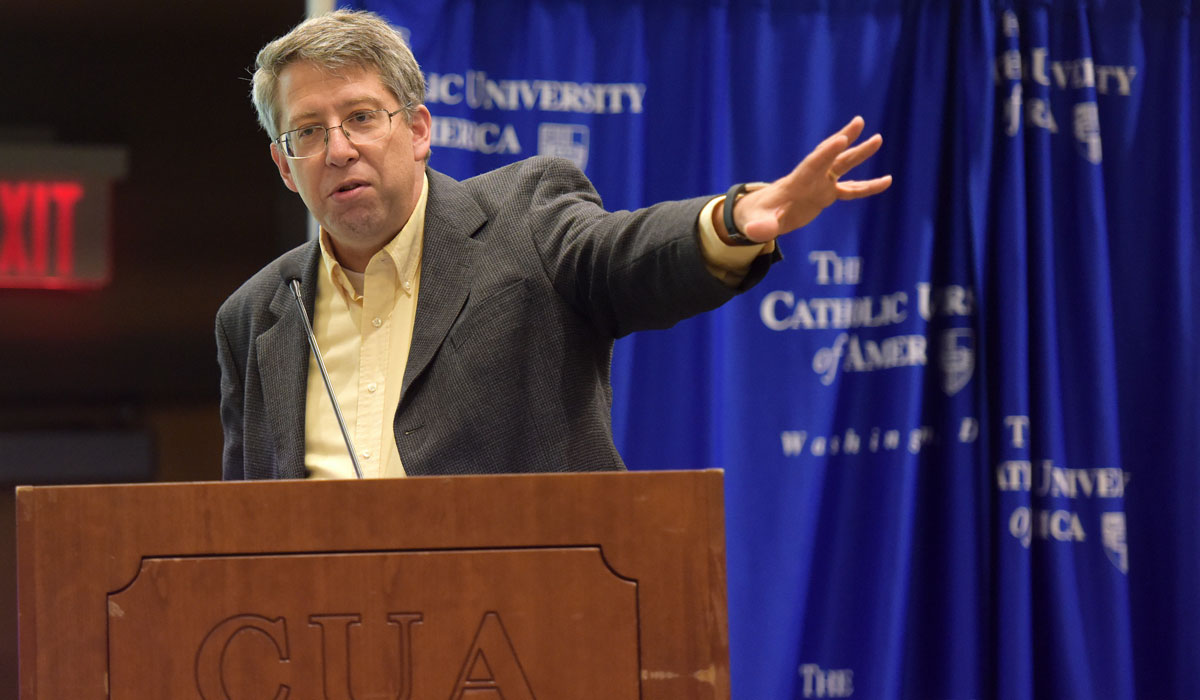

Forensic DNA expert John Butler was the keynote speaker for this year’s Biology Graduate Student Symposium sponsored by the Department of Biology. Butler addressed the University’s students, faculty, and staff on “Forensic Science and DNA Testing: Past, Present, and Future” on Nov. 1 in the Edward J. Pryzbyla University Center.
Butler has pioneered the methods used today for DNA testing in criminal casework, paternity investigations, and much more. He is the author of several textbooks on forensic DNA testing and is currently at the National Institute of Standards and Technology (NIST) as a fellow and special assistant to the director for forensic science.
“Butler and the work he does represents an interesting connection between science and cultural issues, about applications of sciences, the policies related to them, and personal privacy. I think it cuts across not just the science and humanities departments, but the theology and ethics departments as well,” said Frank Portugal, clinical associate professor and director of the Master of Science in Biotechnology program.
Butler used the O.J. Simpson case as an example to illustrate what forensic testing was like 24 years ago.
“The O.J. Simpson case got a lot of interest of the public in forensic DNA and showed the power of what forensic science can do to help answer questions,” said Butler.
“There was a lot of evidence in that particular case,” Butler said. He was working in the FBI laboratory at the time, working on faster methods. It took about eight weeks to get any results for this particular case. “Within a few years we were able to get it down to less than eight hours and now with the new rapid DNA machines, you can do DNA testing within less than eight minutes.”
Forensic science has had a lot of growth over the years since forensic DNA testing began in 1985, Butler explained. “The first 10 years were around exploration, looking at new marker systems, and new technologies. The next decade was of stabilization, deciding the standard markers that will be used, and quality assurance standards that the FBI has. The next phase was rapid growth in 2015. And now we’re in the sophistication stage because we’re making sense with what we do with all this information. We have all these expanding tool capabilities but have a lot of privacy concerns.”
There's now 18.5 million profiles in the national database, which was authorized in 1994. Butler said these profiles have “assisted in half a million investigations in the last 20 years. Now about 32 states in the federal government take a DNA sample upon arrest depending on the crime. ”
DNA is used in forensic science for the primary purpose of identifying the perpetrator. Butler explained, “We’re trying to make a comparison between the Q, which is the question sample that exists at a crime scene. The K is the known sample coming from the individual. There is always a Q to K comparison in forensic science.”
“We do this process by collecting a sample, storing it, characterizing where it comes from, for instance from blood, or saliva, extracting the DNA and quantifying how much DNA is present, amplifying specific marker sets, separating, generating the data, and giving them to the police or prosecutor.”
The future of forensic science is in rapid DNA technologies. “Rapid DNA will make things faster, we’ll have higher amounts of information in the next generation sequencing, more markers, and we will have the capability of coming to stronger conclusions using robust software systems,” said Butler.
But with these new technologies comes challenges, including consistency, storing large amounts of information, and proper interpretation. “But the most important concern,” Butler says, “is how do we address the privacy concerns of having your genetic information collected and stored.”
Butler explained that forensic science is constantly growing. He wonders what people in the field will do with the new capabilities especially as policy concerns become more prevalent. The Department of Homeland Security is already considering collecting DNA samples from detained immigrants at the borders. “We have to start asking questions and thinking of policy concerns. We have the technology to do lots of things, but what do we do with it? We have to be responsible with it,” said Butler.
Butler’s talk was the Keynote address. Other presentations during the symposium highlighted the research work of biology graduate students. The event also included poster presentations, highlighting research projects from around the department.